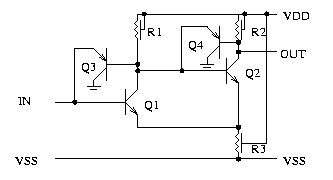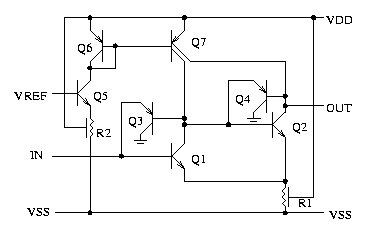

Rising
input voltage:
Q1
is off. Q2 is on and saturated. Parasitc PNP transistor Q4 drains most
of the current flowing through R1. To turn off Q1 the current trough Q2
and the current trough Q1 must flow viar R3. The voltage drop at R3 roughly
calculates as:
V3=R3*VDD / (R2+R3*R2/(R2+R3)
To turn on Q1 a trip point of:
Vin_trip = Vbe+V3
must be reached. Be aware that at the trip point parasitic transistor Q3 turns on and the circuit get a low input impedance!
Falling
input voltage:
Q1
turns off when the input voltage falls below:
Vin_release
= Vbe + VDD*R3 / (R1+R3)

At the trip point the current of both collectors of Q7 flows via R1. The current the PNP sources provide is derived from the reference voltage, Vbe of Q5 and R2. So the upper trip point calulates as:
Vtrip = (Vref-Vbe)*R1 / R2 + Vbe
Choosing R1 = R2 the trip point becomes:
Vtrip=Vref
The lower trip point is reached when Q1 can not carry half of the reference current (Vref-Vbe)/R2 anymore. So the release point is:
Vrelease=(Vref-Vbe)*R1 / (2*R2) + Vbe
This lower trip point or release voltage has a Vbe dependence. Usually either the upper or the lower threshold can be made tracking the reference.